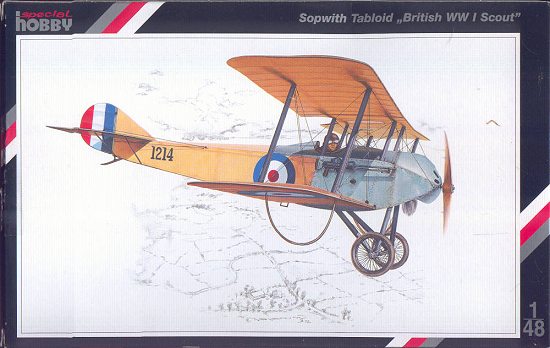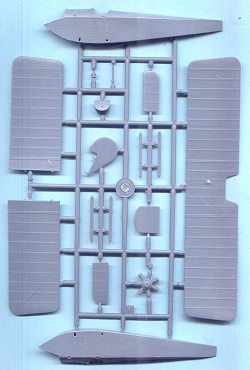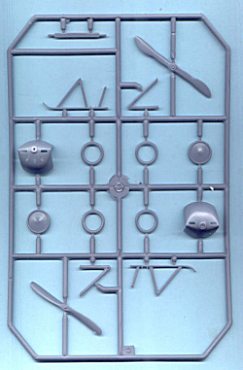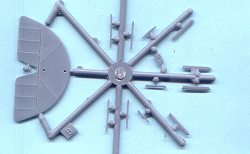
|
KIT: |
Special Hobby 1/48 Sopwith Tabloid |
|
KIT # |
? |
|
PRICE: |
$36.00 MSRP($30.96 from Squadron) |
|
DECALS: |
Three aircraft |
|
REVIEWER: |
|
|
NOTES: |
Short run kit |

|
HISTORY |
The Sopwith Tabloid first appeared in 1913 as a two-seater with pilot and passenger seated side-by-side, powered by an 80 h.p. Gnome LeRhone rotary engine, and was called The Sporting Biplane, since its intended buyers were adventurous sportsmen. It was among the fastest airplanes ever flown in England at the time, with speeds of 80 m.p.h. recorded.
Both the Royal Flying Corps and the Royal Naval Air Service were interested in the airplane due to its performance. Sopwiths modified the design to a single-seater known as the Speedy Scout, and production began in late 1913.
In April 1914, a single-seat Tabloid - one of 12 built for the Royal Flying Corps - was equipped with floats and a 100 h.p. Gnome Monosoupape engine. Flown by Sopwith test pilot Howard Pixton, it became the first British winner of the Schneider Cup Trophy, with a then-stunning performance of 86.78 m.p.h. Later, the Tabloid was progressively developed into the Sopwith Schneider and later the Baby, as a single-seat floatplane fighter which was used throughout the First World War.
After the outbreak of war, the Speedy Scouts were sent to France, where they were used in the reconnaissance role. As air combat developed in the weeks following, Tabloid pilots used their own personal weapons to try and bring down enemy aircraft. In late August, Lt. Norman Spratt, RFC, actually forced an Albatros C.I to land in Allied territory by flying close and opening fire with his revolver. RNAS Tabloid Number 168 was used by Lt. R.L.G. Marix to bomb Zeppelin Z.IX, the first such destruction of an airship by an aircraft. Tabloid Number 167 was used by Capt. Spenser Grey in an attempt to bomb the airship base at Cologne.
As the first of the line of fighting aircraft built by Sopwith - which later became Hawker Aircraft - the Tabloid is a historically-significant design.
|
THE KIT |
 |
 |

|
The only other kit of this type of Sopwith aircraft that has been released was a 1/48 Sopwith Baby made by Eduard. This Special Hobby kit is the only release I know of of the early Tabloid design.
 I rhapsodized about
Special Hobby's Spad VII a few weeks ago. This kit is even nicer. The surface
detail is splendid. The rib tapes are a bit more prominent than they would be
in the real thing, but under a coat of paint they will look much superior to the
"hills and valleys" so many kit manufacturers have used to represent a
fabric-covered wing. The two different kinds of wrap-around cowlings are in the
kit and are very well-molded - a big plus considering the difficult shape.
I rhapsodized about
Special Hobby's Spad VII a few weeks ago. This kit is even nicer. The surface
detail is splendid. The rib tapes are a bit more prominent than they would be
in the real thing, but under a coat of paint they will look much superior to the
"hills and valleys" so many kit manufacturers have used to represent a
fabric-covered wing. The two different kinds of wrap-around cowlings are in the
kit and are very well-molded - a big plus considering the difficult shape.
The kit comes on two sprues of grey plastic, with a photo-etch fret from Eduard that includes seat belts and the engine electrical harness. Decals are included for three aircraft, two from the RFC and one from the RNAS.
|
CONCLUSIONS |
This looks like an extremely easy kit to build into what will be a very nice model. It is even simpler in production design than was the very good Spad VII, and could be recommended without hesitation to a modeler considering their first World War I kit. This one is rocketing towards the top of my "to do" pile.
Review Kit Courtesy Of My Wallet!
If you would like your product reviewed fairly and quickly by a site that has well over 150,000 visitors a month, please contact me or see other details in the Note to Contributors.